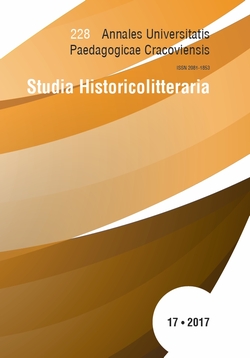Pirandello jako widz zawodowy
Main Article Content
Abstrakt
Pirandello as professional spectator
Abstract
Luigio Pirandello’s drama were unfailingly popular with Polish directors between the beginningof the 1960s until the 1970s. Native creators have undertaken dramas from differentperiods of the Nobelist’s output and covering various topics - bourgeois comedy to metatheatricalworks. Most probably those do not include all that were staged then.It appears that an increased interest in the author is to be connected with the 25th anniversaryof his death, as is suggested by Mieczysław Brahmer in the 1961 Tak jest, jak się państwu zdaje(directed by Zofia Wiercińska).The fact that both then and now critics and researchers in the majority of cases assumed, notnecessarily consciously, they are writing about an artist that is mainly a writer and only thena critic of stage productions of his dramas and a stage producer for his own texts is significant.As a consequence they focused mainly on deconstructing the “pirandellism” condemned byBrahmer, in particular on its canonical interpretation by Adrian Tilgher. Therefore, the followingquestion comes to mind: what kind of interpretations are possible when Pirandello’sworks (especially the first part of the so-called trilogy of “theatre in a theatre” which consistsof Six Characters in Search of an Author, Each In His Own Way and Tonight We Improvise) areconsidered from the perspective of purpose, that is individual theatrical activity of Pirandelloas a co-founder, principal and stage producer of Teatro D’Arte in Rome (in operation between1924 and 1928). The present article attempts at showing the possible direction of a search foran answer to said question with the starting point being the 1962 production of Sześć postaciscenicznych w poszukiwaniu autora (Six Characters in Search of an Author) directed by MariaWiercińska in Stefan Jaracz Theatre in Łódź.
Keywords: Pirandello in Poland, Maria Wiercińska, first theatre directors in Italy
Downloads
Article Details

Utwór dostępny jest na licencji Creative Commons Uznanie autorstwa – Użycie niekomercyjne – Bez utworów zależnych 4.0 Międzynarodowe.
POLITYKA PRAW AUTORSKICH
Wydawca „Annales Universitatis Paedagogicae Cracoviensis. Studia Historicolitteraria” jest upoważniony do korzystania oraz do rozpowszechniana wszystkich opublikowanych w czasopiśmie materiałów na podstawie umowy licencji niewyłącznej, zawartej uprzednio na czas nieoznaczony każdorazowo z autorem/ką konkretnego utworu na określonych w tamtejszej umowie polach eksploatacji.
POLITYKA OTWARTEGO DOSTĘPU
„Annales Universitatis Paedagogicae Cracoviensis. Studia Historicolitteraria” to czasopismo o otwartym dostępie, a cała jego zawartość jest dostępna bezpłatnie dla użytkowników i instytucji na zasadach licencji niewyłącznej CreativeCommons (CC BY-NC-ND 4.0). Użytkownicy/ki mogą czytać, pobierać, wykonywać kopie, rozpowszechniać, drukować, wyszukiwać lub linkować do pełnych tekstów artykułów w tym czasopiśmie bez uprzedniej zgody wydawcy lub autora/ki pod warunkiem podania źródła dostępu i autorstwa danej publikacji. Jest to zgodne z definicją otwartego dostępu BOAI (http://www.soros.org/openaccess).
Bibliografia
Brahmer M., Luigi Pirandello, w programie spektaklu Sześć postaci scenicznych w poszukiwaniu autora w reż. M. Wiercińskiej, prem. 31 III 1962, Teatr im. S. Jaracza w Łodzi, http://www.e-teatr.pl/pl/programy/2013_11/50748/szesc_postaci_w_poszukiwaniu_autora__teatr_im_jaracza_lodz_1962.pdf [dostęp: 3.08.2017].
Brahmer M., Spotkanie po 25 latach, „Listy Teatru Polskiego” 1961–1962, nr 51, http://www.e-teatr.pl/pl/programy/2013_11/52024/tak_jest_jak_sie_panstwu_zdaje_teatr_polski_warszawa_1961.pdf [dostęp: 18.07.2017].
Brahmer M., Wstęp, [w:] L. Pirandello, Dramaty, wstęp i nota M. Brahmer, wyb. oprac. J. Gałuszka, Warszawa 1960, s. 5–21.
Bronowski C., Due rappresentazioni metateatrali di Luigi Pirandello a Varsavia negli anni venti, „Quaderni PAU” 2003, nr 25/26, s. 179–184.
Bronowski C., La fortuna di Luigi Pirandello in Polonia negli anni settanta e ottanta del novecento, „Quaderni PAU” 2003, nr 27/28, s. 175–180.
Encyklopedia teatru polskiego, http://encyklopediateatru.pl/ [dostęp: 3.08.2017].
Eustachiewicz L., Luigi Pirandello, Warszawa 1982.
Fiorato A.Ch., Les Six personnages de Pirandello et le «mal» du theatre, http://chroniquesitaliennes.univ-paris3.fr/PDF/6/6fioratorelu.pdf [dostęp: 3.08.2017].
Fried I., Il convegno Volta sul teatro drammatico. Roma 1934, Corazzano–Pisa 2014.
Grotowski J., Reżyser jako widz zawodowy, [w:] tegoż, Teksty zebrane, red. A. Adamiecka-Sitek i in., Warszawa–Wrocław 2013, s. 773–786.
Kucharuk S., Pirandello i Szaniawski. Przyczynek do badań komparatystycznych, Lublin 2011.
Kucharuk S., Polska krytyka wobec dramatów Pirandella, „Italica Wratislaviensia” 2012, nr 3, s. 107–121.
Niccodemi D., L’autore alla prova, [w:] L. Pirandello, Sei personaggi in cerca d’autore, red. G.D. Bonino, Torino 2013, s. 189–193.
Osterwa R., Raptularz kijowski, wstęp i oprac. I. Guszpit, Wrocław 2010.
Pirandello L., Illustratori, attori e traduttori, http://www.classicitaliani.it/pirandel/saggi/pirandello_arte_scienza.htm#III [dostęp: 3.08.2017].
Pirandello L., Sei personaggi in cerca d’autore, red. G.D. Bonino, Torino 2013.
Pirandello L., Sześć postaci scenicznych w poszukiwaniu autora, przeł. Z. Jachimecka, [w:] tegoż, Dramaty, wstęp i nota M. Brahmer, wyb. oprac. J. Gałuszka, Warszawa 1960, s. 23–116.
Poggiali F., Giorgio De Lullo regista pirandelliano. Dal teatro alla televisione, Sesto San Giovanni 2013.
Ruffini F., Pirandello e Artaud. Una nota, [w:] tegoż, Per piacere. Itinerari intorno al valore del teatro, Roma
, s. 69–76, http://www-static.cc.univaq.it/culturatea/materiali/Ruffini/pirandello/pirandello.php [dostęp: 3.08.2017].
„Sześć postaci”, czyli wóz transmisyjny, www.encyklopediateatru.pl/artykuly/83690/szesc-postaci-czyli-woz-transmisyjny [dostęp: 3.08.2017].
Zając J., Dwie koncepcje dramatu: D’Annunzio–Pirandello, Kraków 2003.
